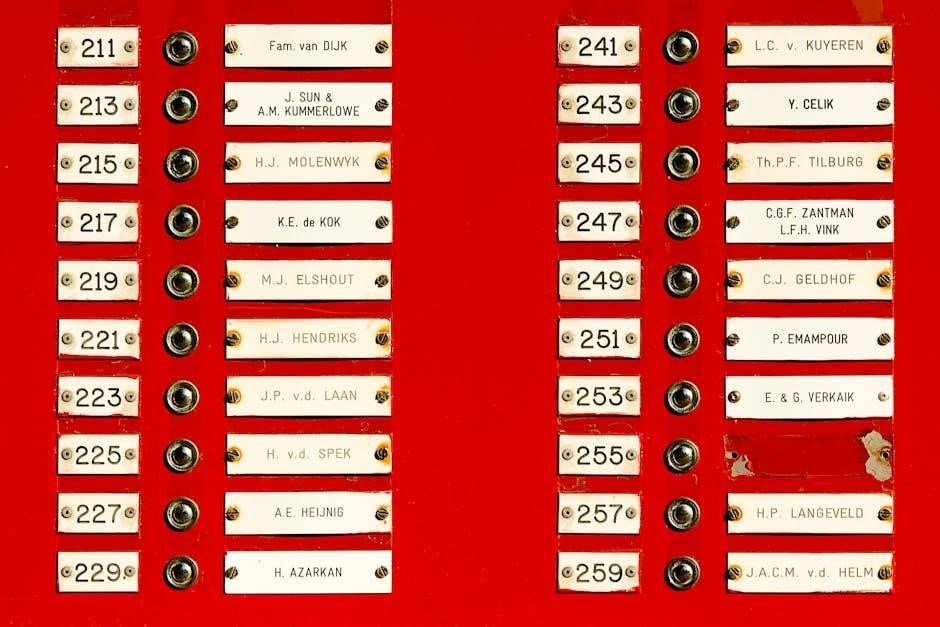1.1 Overview of the Standard
J-STD-001 is the industry standard for soldered electrical and electronic assemblies, ensuring quality and reliability. The PDF document provides detailed requirements and guidelines for manufacturers, widely recognized globally and regularly updated.
J-STD-001 is the globally recognized standard for soldered electrical and electronic assemblies, ensuring quality, reliability, and performance. It provides detailed material, process, and acceptability requirements, supported by IPC-HDBK-001 for additional guidance. The standard is widely adopted across industries and is available in PDF format for easy access, ensuring manufacturers meet stringent criteria for soldered connections in electronic manufacturing.
1.2 Importance in Electronics Manufacturing
J-STD-001 ensures reliable soldered connections, crucial for product performance and safety. Its broad adoption in manufacturing, especially in high-reliability sectors like space and military, underscores its significance. By contributing to quality assurance and defect prevention, the standard ensures the durability of electronic assemblies, making it indispensable in the industry and readily available in PDF format for easy access.

Purpose and Scope of J-STD-001
J-STD-001 prescribes material, process, and acceptability requirements for soldered electrical and electronic assemblies, ensuring quality and reliability. It is used in conjunction with IPC-HDBK-001 and IPC-A-610.
2.1 Material Requirements
J-STD-001 specifies requirements for materials used in soldered electrical and electronic assemblies, including solder alloys, fluxes, and cleaning agents. These specifications ensure compatibility, reliability, and durability of the final product. The standard details acceptable material properties to prevent contamination and ensure optimal performance in various applications, aligning with industry best practices for manufacturing excellence.
2.2 Process Requirements
J-STD-001 outlines specific process requirements for soldering operations, including temperature controls, flux application, and cleaning methods. These processes ensure consistent, high-quality solder joints, minimizing defects and enhancing reliability. The standard also provides guidelines for handling and storing components to prevent damage and contamination during assembly, aligning with best practices for electronics manufacturing.
2.3 Acceptability Requirements
J-STD-001 establishes clear acceptability criteria for soldered joints, ensuring visual and functional integrity. It specifies acceptable conditions for solder coverage, wetting, and surface quality, while defining unacceptable defects like solder balls and bridges. These criteria align with industry standards, providing a consistent benchmark for quality control in electronics manufacturing, as detailed in the PDF document.

Key Documents Related to J-STD-001
IPC-A-610, IPC-HDBK-001, and IPC-AJ-820 are essential companions to J-STD-001, offering detailed acceptability criteria, practical guidance, and additional explanations to support the standard’s requirements, all accessible in PDF format.
3.1 IPC-A-610
IPC-A-610 provides visual acceptability criteria for electronic assemblies, complementing J-STD-001. It defines criteria for soldering, component placement, and inspection, ensuring high-quality production. Often used alongside J-STD-001, it helps manufacturers meet industry standards, with both documents available in PDF format for easy reference and implementation in various manufacturing environments.
3.2 IPC-HDBK-001
IPC-HDBK-001 serves as a comprehensive guide for understanding and implementing J-STD-001 requirements. It offers detailed explanations, illustrations, and practical examples to enhance the application of soldering standards. This handbook supports manufacturers in achieving compliance and improving assembly quality, making it an essential resource for professionals working with J-STD-001 in electronics manufacturing environments.

Applications of J-STD-001
J-STD-001 is crucial for space, military, aerospace, and consumer electronics. It ensures reliable soldering, meeting stringent quality requirements across these critical industries;
4.1 Space Applications
The IPC J-STD-001 addendum for space applications provides specialized criteria for manufacturing soldered electrical assemblies in space environments. Developed by the IPC Space Electronic Assemblies Task Group, it ensures high reliability and durability for critical space electronics, addressing unique challenges like extreme temperatures and radiation exposure.
4.2 Military and Aerospace
J-STD-001 is crucial for military and aerospace industries, ensuring soldered assemblies meet rigorous quality and reliability standards. The standard’s adherence to material and process requirements supports mission-critical applications, aligning with IPC-A-610 and IPC-HDBK-001 for comprehensive guidance, thus enhancing performance and safety in demanding operational environments.
4.3 Consumer Electronics
J-STD-001 plays a vital role in consumer electronics by ensuring high-quality soldered assemblies. Its material and process requirements help manufacturers maintain reliability and performance in high-volume production. The standard aligns with IPC-A-610 and is supported by IPC-HDBK-001, providing clear guidelines for cost-effective and efficient manufacturing processes in the fast-paced consumer electronics industry.

Training and Certification
J-STD-001 offers comprehensive training programs, ensuring professionals master soldering standards. Certification benefits include enhanced skills, compliance assurance, and industry recognition, supported by resources like IPC-HDBK-001.
5.1 Training Programs
Comprehensive training programs for J-STD-001 are available, offering both classroom and online formats. These programs cover soldering techniques, process control, and compliance. Hands-on training ensures practical proficiency, while theoretical sessions provide in-depth understanding. Certification ensures adherence to global standards, enhancing manufacturing quality and reliability. IPC offers regular updates to align with the latest PDF document requirements.
5.2 Certification Benefits
Certification to J-STD-001 enhances credibility and marketability, ensuring proficiency in soldering standards. It validates expertise in process control, materials, and acceptability criteria. Certified professionals meet global industry requirements, improving manufacturing quality and reliability. The certification also provides access to exclusive resources, such as the latest PDF updates and IPC-HDBK-001 guidelines, fostering continuous improvement and compliance.

Global Recognition
6.1 Industry Adoption
J-STD-001 is globally recognized as the premier standard for soldered electrical and electronic assemblies. Its widespread adoption ensures consistency and reliability across industries, supported by regular updates and international collaboration.
J-STD-001 is widely adopted across industries, including aerospace, military, and consumer electronics, ensuring consistent quality and reliability in soldered assemblies. Its global recognition stems from its comprehensive requirements and regular updates, reflecting input from 18 countries. This standard is integral to manufacturing processes worldwide, supported by collaboration and continuous improvement efforts to meet evolving industry needs and technological advancements.
6.2 International Collaboration
The development of J-STD-001 involves global collaboration, with input from 18 countries ensuring comprehensive updates. This international effort integrates diverse expertise, aligning the standard with worldwide industry needs. Regular revisions incorporate the latest criteria, maintaining its relevance and applicability across borders. Such cooperation underscores the standard’s universal adoption and reliability in electronics manufacturing.
Updates and Revisions
J-STD-001 is regularly updated to reflect industry advancements. The latest version, J-STD-001H, includes an addendum for space applications, ensuring the standard remains relevant and comprehensive for evolving manufacturing needs.
7.1 Latest Version (J-STD-001H)
The latest version, J-STD-001H, incorporates updates to align with emerging technologies and industry needs. It includes an addendum for space applications, developed by the IPC Space Electronic Assemblies Task Group. This version is supported by IPC-HDBK-001 for additional guidance and features enhanced graphics for improved clarity and ease of use, ensuring the standard remains current and comprehensive for global manufacturing requirements.
7.2 Revision History
J-STD-001 has evolved through revisions to address industry advancements. Earlier versions laid the groundwork, while the latest updates in J-STD-001H incorporate feedback from global experts, ensuring alignment with modern manufacturing needs and emerging technologies. Regular revisions reflect the collaborative effort of task groups and industry leaders, maintaining its relevance and applicability across various sectors.
Synergy with IPC-A-610
J-STD-001 is developed in synergy with IPC-A-610, ensuring compatibility and complementary requirements. While IPC-A-610 focuses on acceptability criteria, J-STD-001 covers materials and processes, avoiding conflicts unless explicitly required.
8.1 Joint Development Process
J-STD-001 and IPC-A-610 are developed collaboratively by global task groups, ensuring alignment and consistency. Task Group (5-22A), Task Group Asia (5-22ACN), and Task Group India (5-22AIN) contribute to updates, reflecting industry needs. This joint effort ensures the standards remain relevant and adaptable to emerging technologies, with user participation encouraged for future revisions.
8.2 Harmonization of Standards
J-STD-001 is harmonized with IPC-A-610 to ensure consistency and avoid duplication. This alignment provides clarity for manufacturers, reducing confusion. The standard is supported by IPC-HDBK-001, offering additional guidance. When J-STD-001 is cited, IPC-A-610 requirements do not apply unless specified, maintaining a clear order of precedence as defined in procurement documents.
Support and Resources
9.1 IPC-HDBK-001
IPC-HDBK-001 provides detailed guidance and explanations for implementing J-STD-001 requirements, offering practical insights for manufacturers.
9.2 Technical Support
Technical support is available to assist with understanding and applying J-STD-001 standards, ensuring compliance and effective implementation in production environments.
IPC-HDBK-001 serves as a comprehensive guide, providing detailed explanations and practical insights to support the implementation of J-STD-001 requirements. This handbook is essential for manufacturers seeking to understand and apply the standard effectively, offering additional information and examples to ensure compliance and high-quality soldered assemblies.
Technical support for J-STD-001 is provided by the IPC organization, ensuring manufacturers have access to resources and expertise. This includes guidance on implementation, troubleshooting, and interpreting requirements. Regular updates and revisions are supported by task groups, ensuring the standard remains relevant and effective for global electronics manufacturing needs, fostering compliance and innovation in soldering processes.

Order of Precedence
When J-STD-001 is cited in contracts, its requirements take precedence over IPC-A-610 unless explicitly stated otherwise. The order of precedence is defined in procurement documents to ensure clarity and compliance in manufacturing processes, avoiding conflicts between standards.
10.1 Contractual Requirements
When J-STD-001 is cited in contracts, its requirements take precedence over IPC-A-610 unless explicitly stated otherwise. Contractual agreements must clearly define the order of precedence to avoid conflicts, ensuring compliance with specified standards. This ensures manufacturers adhere to the correct criteria for soldered assemblies, maintaining quality and reliability in production processes. Proper documentation is essential to prevent misunderstandings.
10.2 Procurement Documents
Procurement documents must clearly outline the order of precedence when multiple standards like J-STD-001 and IPC-A-610 are referenced. The hierarchy ensures that manufacturers comply with the correct criteria for soldered assemblies. This clarity is crucial for maintaining product quality and reliability, as specified in the contractual requirements. Proper documentation prevents ambiguity and ensures adherence to industry standards.

Download and Access
The J-STD-001 standard is available as a downloadable PDF, offering easy access for manufacturers. Licensing options and multi-user access ensure flexibility for organizations of all sizes.
11.1 PDF Availability
The J-STD-001 standard is readily available as a downloadable PDF document, ensuring easy access for manufacturers and professionals. The latest version, J-STD-001H, is published and can be obtained online. The PDF file size is approximately 3.8 MB, with a redline version also accessible for comparison purposes. This format allows for convenient reference, searchability, and sharing across teams. It can be purchased and downloaded directly from the IPC store or authorized distributors, with licensing options available for flexibility.
11.2 Licensing Options
Licensing options for the J-STD-001 PDF are designed to accommodate different organizational needs. Single-user and multi-user licenses are available, ensuring cost-effective access for teams. The PDF can be purchased directly from the IPC store or authorized distributors, with options for online access and printing. Licensing ensures compliance and flexibility for manufacturers and professionals requiring the standard for their operations.

Industry Impact
J-STD-001 significantly enhances quality assurance and reliability in electronics manufacturing. Its global recognition ensures consistency across industries, improving product performance and maintaining high standards worldwide.
12.1 Quality Assurance
J-STD-001 ensures high-quality soldered assemblies by defining strict material and process requirements. Its global adoption promotes consistency, reducing defects and improving reliability. The standard is supported by IPC resources like IPC-HDBK-001, providing detailed guidance for manufacturers. Regular updates, such as in J-STD-001H, reflect industry advancements, ensuring compliance with modern manufacturing practices and maintaining trust across the electronics industry.
12.2 Reliability Enhancement
J-STD-001 enhances reliability by specifying precise soldering criteria, reducing defects and ensuring durable connections. Supported by IPC-HDBK-001, it provides detailed guidance for manufacturers. The standard’s global recognition and regular updates, such as in J-STD-001H, ensure compliance with advanced manufacturing practices, fostering trust and consistency across the electronics industry. This ensures long-term performance and safety in electronic assemblies.

Development Team
The J-STD-001 development team includes global task groups like 5-22A, 5-22ACN, and 5-22AIN, ensuring expertise and industry-wide collaboration. Their work enhances the standard’s relevance.
13.1 Task Groups
Task Groups like 5-22A, 5-22ACN, and 5-22AIN contribute to J-STD-001’s development, ensuring global expertise. These groups review requirements, align with industry needs, and update standards. Their collaboration ensures the standard remains relevant and effective, supported by resources like IPC-HDBK-001. Users are encouraged to participate in future revisions, enhancing the document’s quality and applicability across industries.
13.2 Contribution Process
The contribution process involves global collaboration, with Task Groups like 5-22A, 5-22ACN, and 5-22AIN leading updates. Users are encouraged to participate, ensuring diverse expertise. The standard is supported by IPC-HDBK-001, offering detailed explanations. This collaborative approach ensures J-STD-001 remains relevant, addressing emerging technologies and industry needs effectively through collective input and continuous improvement.
Future Developments
Future updates will focus on emerging technologies and user participation, ensuring the standard evolves to meet industry demands and global manufacturing needs effectively.
14.1 Emerging Technologies
J-STD-001 is evolving to address emerging technologies like advanced soldering materials, automation, and miniaturization. Updates will include criteria for new manufacturing techniques and environmental considerations, ensuring the standard remains relevant. The PDF document reflects these changes, providing clear guidelines for modern electronics assembly and supporting innovation in the industry.
14.2 User Participation
User participation is crucial for the development of J-STD-001. The standard encourages input from global experts, ensuring it meets diverse industry needs. Task groups, including those in Asia and India, contribute to updates. This collaborative approach ensures the PDF document remains comprehensive and aligned with the latest advancements and user requirements.
J-STD-001 is a cornerstone for ensuring quality and reliability in electronics manufacturing. Its global adoption and regular updates make it indispensable for producing durable soldered electrical assemblies.
15.1 Summary of Key Points
J-STD-001 is the industry standard for soldered electrical and electronic assemblies, ensuring quality and reliability. It provides material, process, and acceptability requirements, supported by IPC-A-610 and IPC-HDBK-001. Recognized globally, it is regularly updated to reflect emerging technologies and industry needs, making it indispensable for manufacturers. The PDF version is easily accessible, ensuring widespread adoption and adherence to its criteria.
15.2 Final Thoughts
J-STD-001 is a cornerstone of electronics manufacturing, ensuring reliable soldered assemblies. Its global recognition, regular updates, and alignment with IPC-A-610 make it indispensable. The PDF version enhances accessibility, allowing manufacturers to adhere to its criteria efficiently. This standard remains vital for maintaining quality and advancing electronic manufacturing technologies, making it a foundational resource for the industry.
